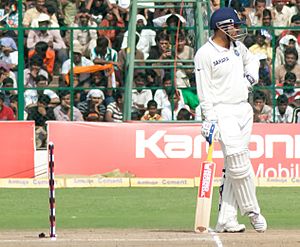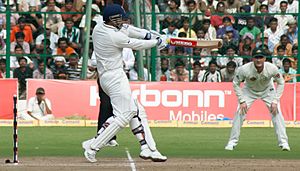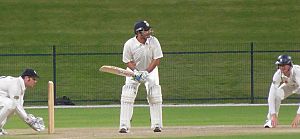Virender Sehwag facts for kids
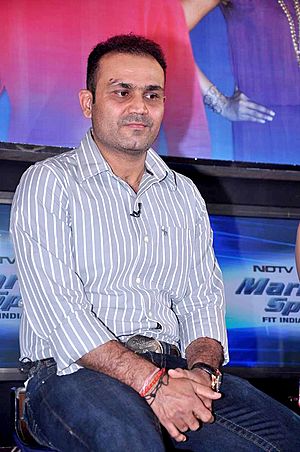
Sehwag in 2012
|
||||||||||||||||||||||||||||||||||||||||||||||||||||||||||||||||||
| Personal information | ||||||||||||||||||||||||||||||||||||||||||||||||||||||||||||||||||
|---|---|---|---|---|---|---|---|---|---|---|---|---|---|---|---|---|---|---|---|---|---|---|---|---|---|---|---|---|---|---|---|---|---|---|---|---|---|---|---|---|---|---|---|---|---|---|---|---|---|---|---|---|---|---|---|---|---|---|---|---|---|---|---|---|---|---|
| Full name |
Virender Sehwag
|
|||||||||||||||||||||||||||||||||||||||||||||||||||||||||||||||||
| Born | 20 October 1978 Najafgarh, Delhi, India |
|||||||||||||||||||||||||||||||||||||||||||||||||||||||||||||||||
| Nickname | Viru, Nawab of Najafgarh, Sultan of Multan | |||||||||||||||||||||||||||||||||||||||||||||||||||||||||||||||||
| Height | 5 ft 8 in (1.73 m) | |||||||||||||||||||||||||||||||||||||||||||||||||||||||||||||||||
| Batting | Right-handed | |||||||||||||||||||||||||||||||||||||||||||||||||||||||||||||||||
| Bowling | Right arm off break | |||||||||||||||||||||||||||||||||||||||||||||||||||||||||||||||||
| Role | Opening batter | |||||||||||||||||||||||||||||||||||||||||||||||||||||||||||||||||
| International information | ||||||||||||||||||||||||||||||||||||||||||||||||||||||||||||||||||
| National side |
|
|||||||||||||||||||||||||||||||||||||||||||||||||||||||||||||||||
| Test debut (cap 239) | 3 November 2001 v South Africa | |||||||||||||||||||||||||||||||||||||||||||||||||||||||||||||||||
| Last Test | 2 March 2013 v Australia | |||||||||||||||||||||||||||||||||||||||||||||||||||||||||||||||||
| ODI debut (cap 123) | 1 April 1999 v Pakistan | |||||||||||||||||||||||||||||||||||||||||||||||||||||||||||||||||
| Last ODI | 3 January 2013 v Pakistan | |||||||||||||||||||||||||||||||||||||||||||||||||||||||||||||||||
| ODI shirt no. | 44 | |||||||||||||||||||||||||||||||||||||||||||||||||||||||||||||||||
| T20I debut (cap 9) | 1 December 2006 v South Africa | |||||||||||||||||||||||||||||||||||||||||||||||||||||||||||||||||
| Last T20I | 2 October 2012 v South Africa | |||||||||||||||||||||||||||||||||||||||||||||||||||||||||||||||||
| Domestic team information | ||||||||||||||||||||||||||||||||||||||||||||||||||||||||||||||||||
| Years | Team | |||||||||||||||||||||||||||||||||||||||||||||||||||||||||||||||||
| 1997–2014 | Delhi | |||||||||||||||||||||||||||||||||||||||||||||||||||||||||||||||||
| 2015 | Haryana | |||||||||||||||||||||||||||||||||||||||||||||||||||||||||||||||||
| 2003 | Leicestershire | |||||||||||||||||||||||||||||||||||||||||||||||||||||||||||||||||
| 2008–2013 | Delhi Daredevils | |||||||||||||||||||||||||||||||||||||||||||||||||||||||||||||||||
| 2014–2015 | Kings XI Punjab | |||||||||||||||||||||||||||||||||||||||||||||||||||||||||||||||||
| Career statistics | ||||||||||||||||||||||||||||||||||||||||||||||||||||||||||||||||||
|
||||||||||||||||||||||||||||||||||||||||||||||||||||||||||||||||||
|
Medal record
|
||||||||||||||||||||||||||||||||||||||||||||||||||||||||||||||||||
|
Source: ESPNcricinfo, 6 January 2016
|
||||||||||||||||||||||||||||||||||||||||||||||||||||||||||||||||||
Virender Sehwag (born 20 October 1978) is a famous former Indian cricket player. He played for India from 1999 to 2013. Many people think he was one of the best opening batsmen of his time. He was known for his powerful and aggressive style of batting.
Sehwag played for teams like Delhi Capitals in the IPL. He also played for Delhi and Haryana in Indian domestic cricket. He batted right-handed. His first One Day International (ODI) match was in 1999, and he joined the Indian Test team in 2001.
In April 2009, Sehwag became the first Indian player to be named the Wisden Leading Cricketer in the World. He won this award for his amazing performance in 2008. He was also the first player from any country to win the award two years in a row (2008 and 2009). He sometimes led the Indian team as vice-captain. Sehwag was part of the Indian teams that won the 2002 ICC Champions Trophy, the 2007 T20 World Cup, and the 2011 Cricket World Cup. In 2023, he was added to the ICC Cricket Hall of Fame.
Sehwag holds several cricket records. He made the highest score by an Indian in Test cricket, scoring 319 runs against South Africa. This was also the fastest triple century in Test history, reaching 300 runs in just 278 balls. He is one of only four batsmen in the world to have scored over 300 runs twice in Test cricket. Sehwag also has the highest strike rate in Test matches among batsmen with at least 3000 Test runs.
In December 2011, he scored his first double century in ODI cricket. He made 219 runs off 149 balls against the West Indies. This was the highest individual score in ODI cricket at that time. He is one of only two players in the world to have scored a double century in ODIs and a triple century in Test cricket.
Contents
Early Life and Cricket Start
Virender Sehwag was born into a Jat family. His father was a grain merchant. He grew up in a big family with many relatives. The Sehwag family is from Haryana, but they later moved to New Delhi. Virender was the third of four children.
His father said that Virender's love for cricket started when he was just seven months old and was given a toy bat. He went to Arora Vidya School in Delhi. He really wanted to play cricket because he felt he wasn't very good at schoolwork. His coach, Amar Nath Sharma, helped him become an attacking batsman. When he was a child in 1990, he broke a tooth, and his father tried to stop him from playing cricket. But his mother helped him continue. Later, he studied at Jamia Milia Islamia for his graduation.
Playing for Teams in India
Starting in First-Class Cricket
Sehwag began playing first-class cricket for the Delhi cricket team in the 1997–98 season. The next year, he was chosen for the North Zone cricket team for the Duleep Trophy. He scored a lot of runs in that tournament. In February 1999, he played for the Board President's XI against Pakistan. He scored 66 runs in that game.
He continued to play well, scoring 274 runs in a Duleep Trophy match. This was the highest score in that competition. He also scored a quick 187 runs in a Ranji Trophy match. Because of his consistent good play, he became a regular member of the national team in mid-2001. Even after starting his international career, he kept playing for Delhi when he wasn't busy with international matches. He also led North Zone to win the Deodhar Trophy twice.
Playing in the IPL
Sehwag's record in Twenty20 matches
| Matches | Runs | HS | 100s | 50s | Avg. | |
|---|---|---|---|---|---|---|
| T20I | 19 | 394 | 68 | 0 | 2 | 21.88 |
| IPL | 104 | 2728 | 122 | 2 | 16 | 27.55 |
| CLT20 | 12 | 314 | 66 | 0 | 3 | 28.54 |
Sehwag was the captain of the Delhi Daredevils in the first two seasons of the Indian Premier League. He later stepped down to focus on his batting. However, for the 2011 IPL season, he was the only player kept by the team and became captain again. In the 2012 IPL, he set a record by scoring five half-centuries in a row in T20 matches.
International Cricket Career
One Day International (ODI) Matches
Sehwag's ODI career started slowly. He scored only 1 run against Pakistan in April 1999. He didn't get another chance in the national team for 20 months.
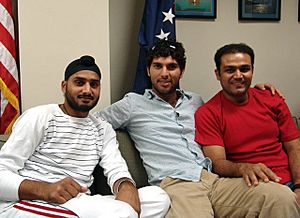
He got another chance in December 2000 against Zimbabwe. Sehwag became well-known in his fourth ODI match in March 2001. He scored 58 runs off 54 balls against Australia. He also took three wickets, helping India win and earning his first Man of the Match award.
His big breakthrough came in Sri Lanka in August 2001. He was asked to open the batting because Sachin Tendulkar was injured. In a match against New Zealand, he scored his first century, making 100 runs off just 69 balls. This was one of the fastest ODI centuries for an Indian player at that time. This performance helped him get a regular spot in the ODI team. He later broke his own record by scoring a century in 60 balls against New Zealand in 2009.
In November 2001, Sehwag faced a problem during a Test match against South Africa. The match referee, Mike Denness, banned him for one Test for "excessive appealing." This caused a big argument between the Indian cricket board and the ICC. Eventually, Sehwag was dropped from the next Test match against England. In 2015, Sehwag said that he thought about retiring in 2007 when he was dropped from the team, but Sachin Tendulkar convinced him not to.
When Saurav Ganguly was injured in January 2002, Sehwag got another chance to open the innings. He scored 82 runs off 64 balls, helping India win. Because he played so well as an opener, he became a permanent opening batsman. In 2002, he scored 271 runs in the 2002 ICC Champions Trophy in Sri Lanka. He was Man of the Match twice in that tournament. He scored 126 runs against England and 58 runs against South Africa, helping India reach the final.
In late 2002, he scored an unbeaten 114 runs against the West Indies. He also made two centuries against New Zealand in a 7-match ODI series.
Challenges and Comeback
Virender Sehwag had a tough time in the 2003 Cricket World Cup. He scored 299 runs but only averaged 27. He scored 82 runs in the final against Australia, which India lost.
In 2003 and 2004, he struggled to be consistent in ODIs. He scored only one century and three half-centuries in 22 matches. Despite this, he won three Man of the Match awards in 2004 and 2005. He scored 108 runs against Pakistan in Kochi, which helped India win. For his good performances in 2004, the ICC named him in the World ODI XI team.
Sehwag then went two years without scoring a century in ODIs. He also had to leave a tour of Pakistan early in 2006 due to a shoulder injury. He was even dropped from the ODI team. However, captain Rahul Dravid insisted that he be included in the 2007 Cricket World Cup squad. Sehwag started the 2007 World Cup poorly, but then scored a great 114 runs against Bermuda. India scored 413 runs, the highest team total in a World Cup match at that time.
On 11 March 2009, Sehwag hit India's fastest ODI century against New Zealand, reaching 100 runs in just 60 balls. This helped India win their first series in New Zealand. On 8 December 2011, Sehwag scored his highest ODI score of 219 runs against the West Indies in Indore. He also passed 8,000 runs in ODI cricket during this innings. This performance was voted the best ODI batting performance of the year by ESPNcricinfo. He was also named in the World ODI XI by the ICC for his performances in 2011.
Sehwag's scoring rate in ODIs was very fast, at 103.44 runs per 100 balls. He was very successful when chasing runs, scoring seven of his fifteen centuries while batting second.
Test Match Career
Sehwag's first century in mid-2001 was not enough to get him into the Test team right away. He made his Test debut in late 2001 against South Africa. He scored 105 runs in his first Test match. He was later promoted to open the batting during the 2002 England tour. He scored 84 runs at Lord's and then a century at Trent Bridge. Since then, he has always opened the batting in Test matches.
He scored his first home century of 147 runs against the West Indies in 2002–03. After a difficult tour to New Zealand, he scored 130 runs in a Test match at Mohali in late 2003.
In early 2004, he became the first Indian to score a triple century (300 runs) in Test cricket. He scored 309 runs against Pakistan in Multan. This broke V. V. S. Laxman's previous Indian record of 281 runs. India won the match, and Sehwag was named Man of the Match. He later sold the bat he used to score the triple century to help victims of the 2004 tsunami.
| Sehwag's results in international matches | ||||||
|---|---|---|---|---|---|---|
| Matches | Won | Lost | Drawn | Tied | No result | |
| Test | 104 | 42 | 28 | 34 | 0 | – |
| ODI | 251 | 133 | 103 | – | 1 | 14 |
| T20I | 19 | 11 | 6 | – | 1 | 1 |
In 2004, Sehwag was fined for arguing with the umpire during a Test match against Australia. The umpire later apologized. Sehwag scored 155 runs in the Chennai Test match that year. In a home series against South Africa, he scored 164 runs and 88 runs, helping India win the series. He was again named Man of the Series.
In 2005, he scored 173, 81, and 201 runs in a home series against Pakistan. He scored a total of 544 runs in that series and won the Man of the Series award. He also passed 3000 runs in Tests during this time, becoming the fastest Indian to reach this milestone. His great performances earned him a spot in the ICC Test Team of the Year.
In January 2006, Sehwag scored 254 runs against Pakistan in Lahore. This was the highest Test score ever at a strike rate of over 100. He and Rahul Dravid had a 410-run partnership, which was almost a world record for opening batsmen. During the 2006 West Indies tour, Sehwag scored 180 runs and took four wickets, earning him the Man of the Match award. He was also used more as a bowler in Test matches during this tour.
Sehwag was dropped from the Test team in 2007 due to poor form. However, he was called back for India's tour of Australia in December 2007. He played an important role in India's win in the third Test in Perth, scoring 72 runs and taking two wickets. He also scored a match-saving 151 runs in the fourth Test in Adelaide. This was his first century in the second innings of a Test match, showing a more careful batting style.
Sehwag continued his excellent form against South Africa in April 2008. He scored 319 runs in the first Test in Chennai. He reached 300 runs in just 278 balls, making it the fastest triple century in Test history. Sehwag became only the third batsman, after Sir Donald Bradman and Brian Lara, to score two triple centuries in Test cricket. He scored 257 runs on the third day of that match, which was the most runs scored by a batsman in a single day of a Test match since 1954.
He is known for scoring very big centuries. His last eleven centuries were all over 150 runs, including two triple centuries and three double centuries. His innings of 201 not out was voted the Best Test Batting Performance of 2008 by ESPNcricinfo.
In December 2008, Sehwag's quick 83 runs off 68 balls against England in Chennai helped India chase a record target of 387 runs. This was the highest successful run chase in India. He was named Man of the Match for this effort. For his performances in 2008, he was named in the World Test XI by ICC and ESPNcricinfo.
During Sri Lanka's tour of India in 2009, Sehwag was the top run-scorer in the Test series with 491 runs. In the last Test match, he scored 293 runs, helping India win. He almost became the only player to score three triple centuries, but he was caught out just seven runs short. This innings was described by him as his third best, after his two triple centuries. This performance was voted the Best Test Batting Performance of 2009 by ESPNcricinfo. For his performances in 2010, he was named in the World Test XI by the ICC.
Playing Style
In his early career, Sehwag was often compared to Sachin Tendulkar because of their similar batting styles. Sehwag himself said he tried to copy Tendulkar's style when he was young.
Sehwag's batting technique was unique. He often moved away from the stumps to hit the ball with power. He was known for his strong square cuts and upper cuts. He was also good at the late cut. He often hit the ball in the air, which was risky but showed his brave approach. He didn't move his feet much, relying on his excellent eyesight for timing.
Sehwag was famous for his very attacking batting style. In 2005, Wisden Cricketers' Almanack called him the "most exciting opener in the world" in Test matches. He was known for hitting aggressively even when his team was in a difficult situation. This helped him not worry about past failures, but sometimes led to too much aggression. Pakistan coach Bob Woolmer called him a "sophisticated slogger." Over the years, his style changed from "reckless hitting" to "controlled aggression."
Sehwag had a much higher batting average in the first innings of Test matches (nearly 68 runs) compared to the second innings (31 runs). This difference showed that he sometimes struggled in tougher batting conditions as the pitch wore out. However, his 151 runs in the second innings against Australia in Adelaide and 92 runs in difficult conditions in Nagpur helped change this view. In the 2008 Test series against England, his 83 runs in the fourth innings helped India achieve a record run chase.
In 2011, Sehwag became only the third Indian to get a "king pair" (two golden ducks in a row) in Test cricket. However, he quickly bounced back with two important scores of 55 runs against the West Indies.
By 2012, his form started to decline. He scored fewer runs in both Tests and ODIs and was eventually dropped from the ODI team. Former England batsman Geoffrey Boycott suggested that it might be the end of Sehwag's career. Sehwag was voted as the 4th-scariest batsman to face in a poll of international bowlers.
Personal Life
Sehwag married Aarti Ahlawat in April 2004. Their wedding was a big event with strong security. They have two sons, Aryavir (born in 2007) and Vedant (born in 2010).
Sehwag is known for singing while batting. He said his favorite song to sing was "Chala Jaata Hoon" by Kishore Kumar.
In 2011, Sehwag started the Sehwag International School in Jhajjar, Haryana. It was his father's dream to have a place where students could study, live, train, and play sports. After his second triple century, the Haryana government offered him land for a cricket academy. But he asked to open a school instead, to fulfill his father's dream. In 2017, Sehwag mentioned on the Indian Idol show that 22 students from his school had played for national and state teams in various sports in the previous two years.
International Centuries
Sehwag's aggressive batting style helped him score many centuries. He scored 22 centuries in Test cricket and 15 in One Day International (ODI) matches. In Tests, he scored centuries against almost all Test-playing nations. He is sixth on the list of leading Test century makers for India. In 2001, he became the eleventh Indian player to score a century on his Test debut, with 105 runs against South Africa. He scored his centuries at fourteen different cricket grounds, with eight of them outside India.
He has scored six double centuries (200 runs or more), which is the most by an Indian batsman. A record three of these were against Pakistan. Sehwag is the first Indian to score a triple century (300 runs or more), and he did it twice. He scored 309 against Pakistan in Multan in 2004 and 319 against South Africa in Chennai in 2008. The 319-run innings was the fastest triple century in Test cricket, reaching 300 runs in just 278 balls.
In ODIs, Sehwag's first century was against New Zealand in Colombo in 2001. His highest ODI score of 219 runs was against the West Indies in Indore. He was dismissed five times in the nineties (between 90 and 99 runs).
Awards and Achievements
Virender Sehwag received many awards and honors during and after his career:
- Arjuna Award (2002)
- 2007 – Polly Umrigar Award for International Cricketer of the Year
- Wisden Leading Cricketer in the World (2008, 2009)
- ICC Test Player of the Year (2010)
- Padma Shree (2010)
- On 31 October 2017, the Delhi and District Cricket Association (DDCA) honored Sehwag by naming Gate No.2 at the Arun Jaitley Stadium after him.


